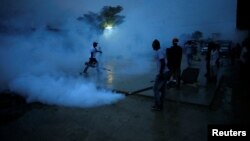Posters warning of the dangers of Zika only reached Haiti's health ministry in August, six months after the country reported an outbreak, in one example of delayed prevention efforts that have health experts worried a "large epidemic" is looming.
Gabriel Thimothe, a senior health ministry official, said the public service posters would be distributed to hospitals and airports shortly, but that health funding had been cut this year and foreign aid was sparse to fight the mosquito-borne virus that can cause severe birth defects.
Zika infections in pregnant women have been shown to cause microcephaly - a defect in which babies' heads and brains are undersized - as well as other brain abnormalities.
Widespread fumigation that has limited the virus' spread in other Caribbean nations such as Cuba only began in Haiti last month. Publicity campaigns have been all but invisible and hospital workers were on strike for much of the year.
"We're expecting a large epidemic but we don't know when it will occur," said Jean-Luc Poncelet, the World Health Organization's representative in Haiti. "There is under-reporting."
Such an epidemic could severely strain Haiti's fragile healthcare system, battered by an earthquake in 2010 that killed 300,000, and still struggling with a cholera epidemic that has sickened nearly 800,000 people.
WHO data show 5,000 suspected cases have been reported in more prosperous neighbor Dominican Republic, which shares the island of Hispaniola with Haiti and has a similar population and climate. Haiti by contrast, has reported 3,000 suspected cases, according to numbers shared by the U.S. Centers for Disease Control and Prevention.
That makes Haiti's Zika infection rate about 30 per 100,000 people, compared to 82 per 100,000 in Brazil, where the connection between Zika and microcephaly was first detected, and 50 per 100,000 in Dominican Republic The connection between Zika and microcephaly first came to light last fall in Brazil, which has since confirmed more than 1,800 cases of microcephaly.
Rainy Season
In the Dominican Republic there were spikes in infections in March and May, broadly coinciding with rainy seasons on both sides of the island, a time when mosquitoes and diseases they carry normally flourish. In Haiti, the number of cases reported each week generally dropped from February through the rains.
A long strike by medical residents at most public hospitals coincided with that decline, raising the question of whether there were fewer infections or a lack of health workers available to register cases.
A Zika task force, which includes the government and non-governmental organizations, was formed in May, Thimothe said. Several U.S. health officials in Haiti told Reuters that the United States provided $3 million in August to combat Zika in the country, money that was initially intended to be deployed against Ebola in West Africa.
Thimothe said the impact of an explosion of microcephaly cases would be devastating, but denied the condition was more widespread than thought, even though many Haitian women give birth at home rather than in clinics.
His position is supported by WHO data through June, which did not show an uptick in microcephaly or Guillain-Barre syndrome, a neurological disorder that can cause temporary paralysis and has also been linked to Zika.
But Louise Ivers, the senior health and policy advisor for Partners in Health, which along with Haitian organization Zanmi Lasante runs a hospital in the central town of Mirebalais, said she had seen at least 12 cases this year of Guillain-Barre, normally a rare condition.
The same hospital registered two microcephaly cases, including one confirmed to be linked to Zika, this summer.
"Maybe we are too late for prevention. Maybe we just have to manage the consequences," Ivers said. "This could just be the tip of the iceberg."









